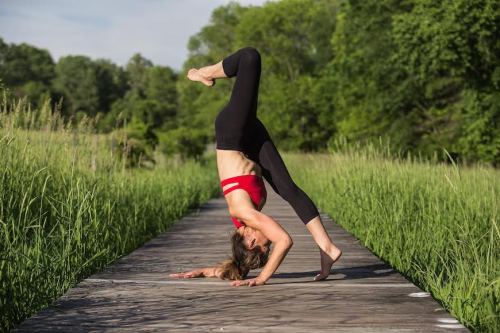I’m a Yoga Teacher-Slash-Physical Therapist—And This Pose Tells You Everything You Need To Know About Your Body
A yoga teacher and physical therapist shares why dolphin pose in yoga is the most revealing, beneficial pose from head-to-toe.

The yoga poses (or “asanas” as they’re called in Sanskrit) can make you feel some type of way—both physically and mentally. So much so that if you listen closely to your body while you’re in any given pose, you can learn a lot about what’s going on with you. And if you ask yoga teacher-slash-physical therapist Lara Heimann, PT, and she’ll tell you that Catur Svanasana, or dolphin pose, offers the most accurate diagnostic for how you’re feeling from head to toe.
Experts in This Article
physical therapist, yoga instructor, and founder of LYT Method
Heimann names dolphin, which is essentially a downward dog on your forearms instead of hands, as the most quote, unquote “all-encompassing” pose of all because it pinpoints your weak points while simultaneously working to fill those gaps. And when I ask her why the pose outshines the millions of other asanas out there, she literally walks me through how Catur Svanasana affects the human body from the neck all the way down to the toes. (Remember, you’re upsidedown—or “inverted”—in this pose!)
First thing’s first, she says, dolphin pose doesn’t put any pressure on the neck, and actually allows it to release—which great news for those of us suffering from text neck. If you find that your neck feels better in dolphin pose than it does the other 23 hours and 59 minutes of the day, you might consider taking more time to stretch your neck and check-in on your posture. For now, though, you can just hang out and imagine your neck growing an inch.
Moving right along to your shoulders. Heimann says dolphin works into a group of muscles called the scapular stabilizers which provide strength and stability all the way from your shoulders to your mid-back. “The scapular stabilizers are huge—and really, really important for shoulder health and optimization. Shoulders are such an area of problems for people, so they’re always asking how to strengthen them—and this is a great way to strengthen them without compression or contraindications for the shoulder,” says Heimann. If your shoulders feel stiff and unyielding in dolphin pose then, there you have it, your shoulders are in need of some serious TLC (… in the form of more time in this very pose).
Up next is the core, which gets a killer workout from simply holding this move. “Getting on your forearms is a direct hit to the core or everything in the cylinder of the torso,” says Heimann. That includes your obliques, low-abdomen, and even up into those scapular stabilizers (also members of the core club, ICYWW). To state it plainly, “You can’t snooze there with the core—all the core muscles are engaged,” says Heimann. You’ll see what she means when you pop into the pose.
The back fascial line is the final piece of your dolphin pose. “It extends from the base of your foot all the way up the back of the leg, into the back, all the way across the neck, across the back of the skull, and over the top of the skull. So it’s basically like a pair of footy pajamas with a hood,” says Heimann. “Any place along that line that’s out of balance will create more strain somewhere else. So opening out that whole back fascial chain is like smoothing out a wrinkled tablecloth.” Feel your feelings in this pose, and you can slowly start to uncover whatever’s wrinkling the tablecloth—so to speak. Ready to try this inversion?
How to safely get into dolphin pose in yoga
1. Unroll your mat and come into a quadruped position with your shoulders directly over your wrists and your hip bones above your kneecaps.
2. Lower onto your forearms so that they’re parallel to one another and shoulder’s width distance apart.
3. Create a cat back by puffing up your shoulder blades, engaging your core, and allowing your head and neck to release. (If you feel constricted in your shoulders, go ahead and interlace your fingers rather than keeping them apart, as you would in a forearm plank.)
4. Push the floor away without letting your head touch the ground. Tuck your toes, lift your knees, and imagine someone or something is physically lifting your hips up to the sky.
5. See if you can stay here for a few breaths, still puffing up your back slightly and pushing through your forearms. Breathe deeply.
6. Gently lower down to your knees and rest.
Sign Up for Our Daily Newsletter
Get all the latest in wellness, trends, food, fitness, beauty, and more delivered right to your inbox.
Got it, you've been added to our email list.










